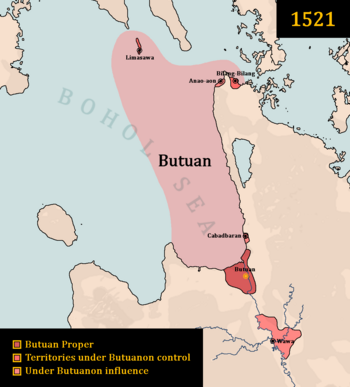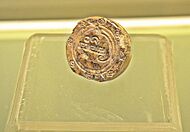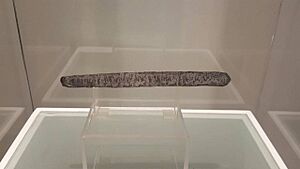Butuan (historical polity) facts for kids
Quick facts for kids
Ancient Butuan
But'ban |
|||||||||
|---|---|---|---|---|---|---|---|---|---|
| Before 1001–1597 | |||||||||

Map of the Rajahnate of Butuan in 1521, with Butuan proper (colored dark brown), its controlled territories (brown), and territories under its influence (light brown).
|
|||||||||
| Capital | Butuan | ||||||||
| Common languages | Butuanon, Old Malay, other Visayan languages | ||||||||
| Religion | Hinduism, Buddhism and animism | ||||||||
| Government | Monarchy | ||||||||
| History | |||||||||
|
• Established
|
Before 1001 | ||||||||
|
• First historical reference by Song dynasty records
|
1001 | ||||||||
|
• Blood compact with Ferdinand Magellan
|
31 March 1521 | ||||||||
|
• Christianization of the polity under Silongan
|
1567 | ||||||||
|
• Area conquered by Spain
|
8 September 1597 | ||||||||
| Currency | Piloncitos, barter rings | ||||||||
|
|||||||||
| Today part of | Philippines | ||||||||
Butuan, also called the Rajahnate of Butuan and the Kingdom of Butuan (Filipino: Kaharian ng Butuan; Butuanon: Gingharian hong Butuan; Cebuano: Gingharian sa Butuan; Chinese: 蒲端國; pinyin: Púduānguó), was a precolonial Bisaya polity (lungsod) centered around northeastern Mindanao island in present-day Butuan, Philippines. It was known for its gold mining, gold jewelry and other wares, and its extensive trade network across maritime Southeast Asia and elsewhere. Over its long history the lungsod had direct trading relationships with the ancient civilizations of China, Champa, Đại Việt, Pon-i (Brunei), Srivijaya, Majapahit, Kambuja, and even Persia as well as areas now comprised in Thailand.
The balangay (large outrigger boats) that have been found along the east and west banks of the Libertad River (the old Agusan River) have revealed much about Butuan's history. As a result, Butuan is considered to have been a major trading port in the Caraga region during the precolonial era.
Contents
Etymology
The name Butuan is believed to have existed long before the Spanish conquistadores arrived in the Philippine archipelago. One possible indication of this is a rhinoceros ivory seal with a design carved in ancient Javanese or early Kawi script (used around the 10th century CE), which, according to a Dutch scholar, was deciphered as But-wan. Another account suggests the name derives from the word batuan, a mangosteen-related fruit common in Mindanao. Another alternative is that the name derives from Datu Bantuan, possibly a former datu of the region.
Historiography
Chinese records
Evidence indicates that Butuan was in contact with the Song dynasty of China by at least 1001 AD. Yuan annal Song Shih recorded the first appearance of a Butuan tributary mission (Lijehan 李竾罕 and Jiaminan) at the Chinese Imperial Court on March 17, 1001, AD. Butuan (or Buotuan 蒲端 in Middle Chinese) around that time was a gold mining and trading hub in northeastern Mindanao, known for manufacturing metal tools and weaponry, musical instruments, and gold jewelry. Butuan was described as a Hindu kingdom with a Buddhist monarchy. The chief (or "king") of Butuan named Kiling sent an envoy under I-hsu-han with a formal memorial requesting equal status in court protocol with the Champa envoy. Researcher Eric Casino believes the name Kiling is not of Visayan origin but rather Indian, because Kiling refers to the people of India. The Sejarah Melayu (Malay Annals) of the nearby country of Malaysia refers to the similarly worded Keling as immigrant people from India. Rajah Kiling's request for diplomatic equality in protocol towards his Rajahnate was later denied by the Chinese Imperial Court, mainly because of favoritism over the Champa civilization.
A new rajah named Sri Bata Shaja later succeeded in attaining diplomatic equality with Champa by sending the flamboyant ambassador Likanhsieh. Likanhsieh shocked the Emperor Zhenzong by presenting a memorial engraved on a gold tablet, some white dragon (bailong 白龍) camphor, Moluccan cloves, and a South Sea slave on the eve of an important ceremonial state sacrifice. This display of irreverence sparked interest from China, and diplomatic relations between the two polities reached their peak during the Yuan dynasty. Later, in the 1300s, the Chinese annal Nanhai Zhi reported that Brunei invaded or administered the Philippine kingdoms of Butuan, Sulu, and Ma-i (Mindoro), which would regain their independence at a later date. After simultaneously regaining their independence together with their Butuanon cousins, the then Hindu state of Sulum which was founded by Visayan immigrants from Butuan and Surigao to the Sulu Archipelago, avenged the invasion of their kingdoms by counter-invading Pon-i (Brunei) and stealing two sacred pearls from Pon-i's rajah.
Spanish colonial period
During the Magellan Expedition, the first held Catholic mass was held in the Philippines. The mass was held on 31 March 1521 in the island of Mazaua (Limasawa) under Rajah Kolambu, and was accompanied by Rajah Siagu, the Rajah of Butuan at the time.
In 1596, the Spanish Catholic mission headed by the Jesuits under Fr. Valerio de Ledesma began in Butuan to establish a Spanish foothold in Mindanao to combat the rising threat of Moros. On 8 September 1597, the first church was eventually inaugurated in Butuan, subjugating Butuan under Spanish rule. The Augustinian Recollects eventually replaced the Jesuits.
Excavated artifacts

Numerous jars have been found in the Butuan area that indicate the wealth of the kingdom and the existence of foreign traditions. Some of these jars have been dated as follows:
- Sathing Phra (900–1100 AD)
- Haripunjaya (800–900 AD)
- Japanese (12th to 16th centuries AD)
- Song dynasty (1001–1271)
- Yuan dynasty (1271–1368)
- Ming dynasty (1368–1521)
- Khmer Empire (802–900 AD)
- Sukhothai Kingdom (1300–1400)
- Champa (1000–1200)
- Persian (9th to 10th centuries AD)
Artifacts have been recovered from within the vicinities of the Ambangan Archeological Site in Libertad that attest to the historical accounts that Butuan traded with India, Japan, Han Chinese, and Southeast Asian countries during these periods.
Recorded monarchs
| Royal title of the reigning rajah | Events | From | Until |
|---|---|---|---|
| Kiling |
|
1001 | 1009 |
| Sri Bata Shaja | Mission by Likanhsieh (李于燮) | 1011 | ? |
| Rajah Siagu | Blood Pact with Ferdinand Magellan | ? | 1521 |
| Linampas | Son of Siagu | 1521 | 1567 |
| Silongan | Ruler of Butuan, converted to Christianity and baptized as Felipe Silongan | 1567 | 1596 |
See also
- Limasawa
- Agusan image
- Butuanon people
- Indian influences in early Philippine polities



